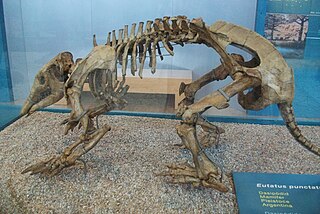This is a list of fossiliferous stratigraphic units in Ecuador .
This is a list of fossiliferous stratigraphic units in Ecuador .
Protocyon is an extinct genus of large canid endemic to South and North America during the Late Pleistocene living from 781 to 12 thousand years ago.

Eutatus is an extinct genus of large armadillos of the family Chlamyphoridae. It was endemic to South America from the Early Miocene to Late Pleistocene, living from 17.5 Ma-11,000 years ago, with possible survival into the early Holocene and existing for approximately 17.49 million years. Based on carbon isotope ratios, it is thought to have been an herbivore that fed on grasses.
The Gokwe Formation is an Early Cretaceous geologic formation in Zimbabwe. Dinosaur remains are among the fossils that have been recovered from the formation, although none have yet been referred to a specific genus. Sediments of the formation may have been laid down in a small shallow lake, carried by intermittent floods from a land surface surrounding the lake on which aeolian transport of sand took place. More likely the animals died on a dry lake bed, and their bones were exposed to a period of desiccation, later floods would scatter the fragments and incorporate them in sediment.
The Tatman Formation is a Wasatchian geologic formation in Wyoming. It preserves fossils dating back to the Ypresian stage of the Eocene period.
The Fannin Formation is a geologic formation in British Columbia. It preserves fossils dating back to the Early Jurassic period.
The Werfen Formation is a geologic formation in the Southern Limestone Alps and Dinaric Alps of Austria, Bosnia and Herzegovina, and Italy. It preserves fossils dating back to the Triassic period.

The Pisco Formation is a geologic formation located in Peru, on the southern coastal desert of Ica and Arequipa. The approximately 640 metres (2,100 ft) thick formation was deposited in the Pisco Basin, spanning an age from the Late Miocene up to the Early Pliocene, roughly from 9.6 to 4.5 Ma. The tuffaceous sandstones, diatomaceous siltstones, conglomerates and dolomites were deposited in a lagoonal to near-shore environment, in bays similar to other Pacific South American formations as the Bahía Inglesa and Coquimbo Formations of Chile.
Pisco Basin is a sedimentary basin extending over 300 kilometres (190 mi) in southwestern Peru. The basin has a 2 kilometres (6,600 ft) thick sedimentary fill, which is about half the thickness of more northern foreland basins in Peru.
The Tablazo Formation is a Middle Pleistocene geologic formation of Santa Elena Province in western Ecuador. The claystones and sandstones were deposited in an estuarine environment.
The Jama Formation is a Pliocene to Early Pleistocene geological formation in Ecuador. The claystones and sandstones were deposited in a coastal environment. The age of the Jama Formation is constrained by 40Ar/39Ar dating of tephra beds. The formation is correlated to the Charco Azul Formation of western Panama and southeastern Costa Rica.
The Canoa Formation is a Piacenzian to Calabrian geologic formation in Ecuador. The sandstones were deposited in a coastal environment. The formation is correlated to the Charco Azul Formation of western Panama and southeastern Costa Rica.
The Esmeraldas Formation is an Early Pliocene geologic formation of the Borbón Basin in northwestern Ecuador.
The Onzole Formation is an Early Pliocene geologic formation in the Borbón Basin of northwestern Ecuador. The formation consists of a shallow marine sandstone member containing many fish fossils, among which megalodon, and a deep water member comprising tuffaceous shales and mudstones containing gastropods, bivalves and scaphopods.
The Angostura Formation is a Late Miocene geologic formation of the Borbón Basin in northwestern Ecuador.

The Dos Bocas Formation is a sedimentary geological formation of the Progreso Basin in southwestern Ecuador. It is dated to the Chattian, about 26 to 24 Ma,.
The Seca Formation is a Late Eocene geologic formation of the Progreso Basin in southwestern Ecuador. The shales of the formation have provided fossils of the marine snake Pterosphenus sheppardi.